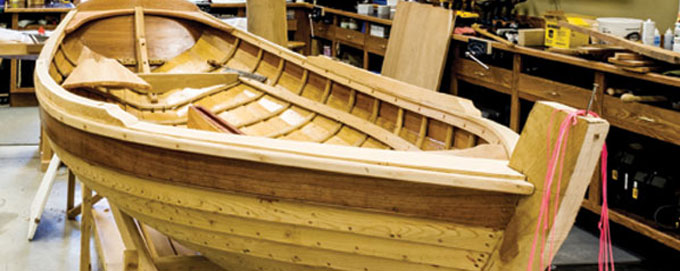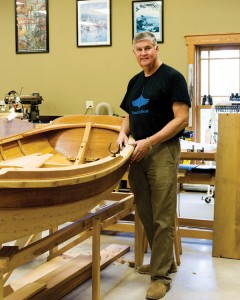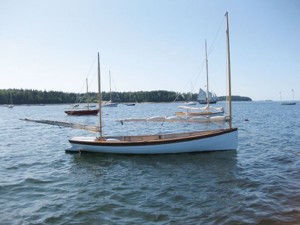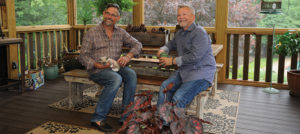
Bob Barnett’s love of boats comes alive in wood
Story by Graham Hadley
Photos by Wallace Bromberg
and courtesy of Bob Barnett
 Sitting in what is easily described as a “dream” workshop a few blocks from Logan Martin Lake is a work of art in wood — a Pete Culler designed Wherry Yawl boat.
Sitting in what is easily described as a “dream” workshop a few blocks from Logan Martin Lake is a work of art in wood — a Pete Culler designed Wherry Yawl boat.
It is the pride and joy of professional structural engineer Bob Barnett — and though the boat-project was started by many hands, it will be his alone that finish it.
Every piece of wood that went into making the boat, every line, from bow to stern, has been carefully handcrafted and expertly fitted together, down to the brass caps where the wood is joined.
Though work on this particular boat has been going on for around four years, wooden boat building has been something Barnett has been moving toward his entire life.
“I grew up around boats. My family had boats, and I was always around the water,” he said. A photo of Bob, his wife Carole and their children on his father’s sailboat adorns the wall of what is possibly the ultimate woodworking shop in St. Clair County.
Over the years, Bob has owned a number of boats, from their Catalina 470 sailboat they keep in Pensacola, Fla., to a variety of Ski Nautique and similar watercraft — even a crab boat, the Lilly G, they converted for recreational use on the lake which resembles the boat from the African Queen, complete with a covered awning that runs the length of the boat.
But there was something special about wooden boats that Bob felt drawn to.
“I saw the wooden boats, but I had no idea how to build one. Then I saw the Wooden Boat School when I was reading Wooden Boat Magazine,” and everything changed, he said.
“I love that school — it is kind of like scout camp with beer,” he said.
The school is located in Brooklin, Maine — which Bob describes as being about like Cropwell, but without the adjoining Pell City.
Between his engineering job, his position as chairman of the board for St. Vincent’s Health Systems, a teaching position at the University of Alabama and a host of other activities, Bob said he can easily be working from 60 to 80 hours a week, sometimes more. So it was a bit of a trick to work in boat-building school.
He finally got his opportunity to take the first class — fundamentals of boat building — because it coincided with a business trip.
The connection to boat building, the school and his instructors was immediate.
“I walked in and there was this guy, my first instructor. He had white hair down to his shoulders — a classic hippie. … He lived totally off the grid — used all hand tools,” Bob said.
 At the time, Bob said, he was the first registered Republican in St. Clair County — “but I learned to love that guy. He was very talented. He showed me how to use hand tools, and once you learn to use hand tools, you can do so much” — and you are much less likely to accidentally cut off a finger.
At the time, Bob said, he was the first registered Republican in St. Clair County — “but I learned to love that guy. He was very talented. He showed me how to use hand tools, and once you learn to use hand tools, you can do so much” — and you are much less likely to accidentally cut off a finger.
Before that, Bob had mostly been using power tools for woodworking — and he still does. His shop, which he built complete with a kitchen, full bathroom and “man cave” area, was custom designed with a dust removal system to work in conjunction with his power tools.
But his love of hand tools is immediately evident, with his hand planes lined, row after row, on shelves along one wall.
Since that first class, Bob — and his wife — have returned to the school again and again, taking classes in everything from boat finishing to sailing. The latter, he admits, was less about the learning and more about getting the chance to go sailing in Maine. Most recently, he was there as an assistant instructor.
Bob says the classes are not just a learning experience, but they are a way for him and the other participants to relax, work together and just enjoy themselves. They take away far more than just the knowledge with them when they leave.
During one sailing class, “there was this older gentleman. I was really worried about him. He could barely get on the boat. By the end of the week, he was climbing all over that thing, even steering the boat. I bet he is still grinning,” Bob said.
As part of those classes, he has built many different wooden boats over the years — always as a group project. But there was something about the Wherry Yawl that resonated with the structural engineer.
“I have built several others, but I have never worked on a boat that has as pretty lines as this one does,” Bob said.
He and his fellow classmates had been working on the Yawl — a sturdy little three-man boat that was used in the 1800s and turn of the century as a kind of water taxi to ferry people from ships at anchor to shore. It has oarlocks, but also a running board and small mast and sail.
“You would pay the man your money, and he would take you out to the boat in one of these,” Bob said. Because of its intended use, the Wherry Yawl is a very strong design, built to withstand even brushing between a ship’s hull and a dock.
He very much wanted the boat, and luck was on his side.
“At the end of class, we would all put our names into a hat. Whoever got their name drawn had to pay for the building materials and supplies and got to keep the boat. I put my name in, and I got to bring it home,” he said.
Though the boat classes can complete a project in a short period of time because there are so many people focused on the work, once home, the Yawl has taken years for Bob to finish because of his busy work schedule.
“I work full-time, plus there is St. Vincent’s, and I teach an engineering class at Alabama — I need to tell them I need to drop all that so I can go build boats,” he joked.
This will be the first boat he will have completed in his shop here — and the work is almost done. It needs a mast and running board set and some other details and then finishing and painting.
That last part is the big hump Bob said he needs to get past — finishing is his least favorite part of the boat build.
“I hate painting,” he said, and a large portion of this boat, especially the outside of the hull, will be painted.
Even so, Bob hopes to have the boat in the water by early summer — and then it is on to his next projects. He has a roll of boat plans in his shop — “I enjoy looking over boat plans more than I like reading a book. It’s the engineer in me.” He wants to build at least three of them.
But he has other projects on his plate, too. The Lilly G is a great crab boat, but that design leaves something to be desired with regards to passenger comfort. Bob plans to build some seating for the boat and relocate the console and controls to better suit its use as a recreational craft.
Then there is the beautiful 1958 Christ Craft Sportsman in another building in the shop complex. The vintage motorboat is a true project — it has minor hull damage on one side and the wood needs to be completely refinished and the interior and engine rebuilt.
“It came ‘what-you-see-is-what-you-get.’ Basically a hull and a pile of parts. I am still looking for original plans. I am not sure what goes where,” Bob said.
But like all his other projects, Bob will figure it out. And when he is done with that, he will move on to something else. Woodworking — he has built all sorts of cabinets and other pieces — and boat building, in particular, are his cathartic escape.
“I picture there always being a boat in this shop. When I finish this one, then I will start another one,” he said.





































